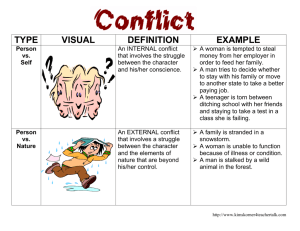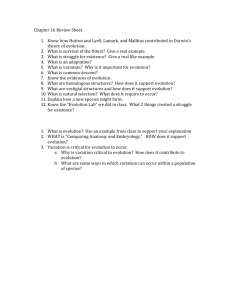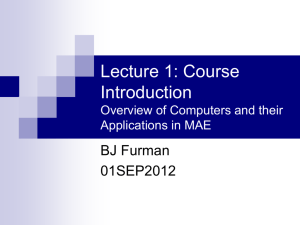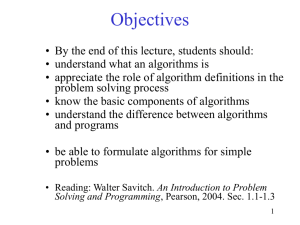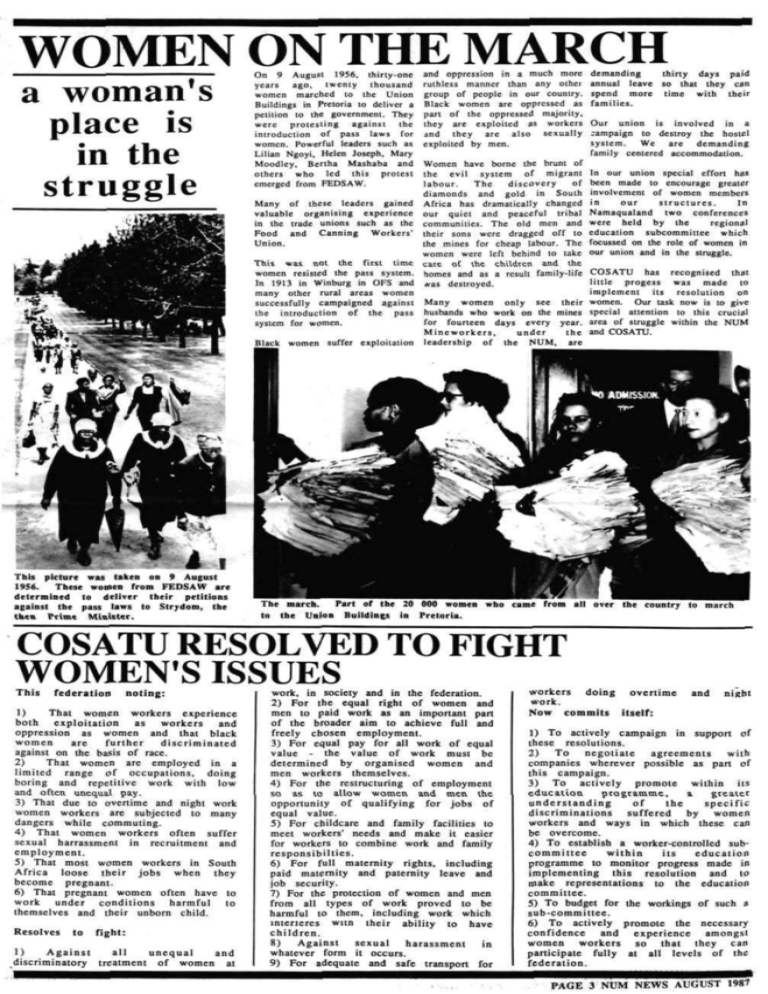
WOMEN ON THE MARCH
»
a woman s
place is
in the
struggle
On 9 Augu5l 1956, thirty-one
years ago, twenty thousand
women marched to the Union
Buildings in Pretoria to deliver a
petition to the government. They
were protesting against the
introduction of pass laws for
women. Powerful leaders such as
Lilian Ngoyi, Helen Joseph, Mary
Moodley, Bertha Mashaba and
others who led this protest
emerged from FEDSAW.
Many of these leaders gained
valuable organising experience
in the trade unions such as the
Food and Canning Workers'
Union.
and oppression in a much more
ruthless manner than any othci
group of people in our country.
Black women are oppressed as
part of the oppressed majority,
they are exploited 3S workers
and they arc also sexually
exploited by men.
Women have borne the brunt of
the evil system of migrant
labour.
The
discovery
of
diamonds and gold in South
Africa has dramatically changed
our quiet and peaceful tribal
communities. The old men and
their sons were dragged off 10
the mines for cheap labour. The
women were left behind to take
care of the children and the
homes and as a result family-life
ivas destroyed.
This was not the first time
women resisted the pass system.
In 1913 in Winburg in OFS and
many other rural areas women
successfully campaigned against Many women only see their
the introduction of the pass husbands who work on the mines
system for women.
for fourteen days every year.
Mincworkcrs,
under
the
Black women suffer exploitation leadership of the NUM, arc
This picture was taken on 9 August
1956.
These women Trots FEDSAW are
determined to deliver their petitions
against the pass laws to Slrydomv the
then Prime Minister.
The march, Part of the 20 000 women
to the Uaio i Buildings in Pretoria.
federation
noting:
1)
That women workers experience
both
exploitation
as
workers
and
oppression as women and that black
women
are
further
discriminated
against on the basis of race.
2)
That women arc employed in a
limited range of occupations, doing
boring and repetitive work with low
and often unequal pay.
3) Thai due to overtime and night work
women workers are subjected lo many
dangers while commuting.
4) That women workers often
suffer
sexual harrassment in recruitment and
employment.
5) That most women workers in South
Africa loose their j o b s when they
become pregnant.
6) That pregnant women often have to
work
under c o n d i t i o n s
harmful
to
themselves and their unbom child.
Resolves
to
fight:
1)
Against
all
unequal
and
discriminatory treatment of women at
work, in society and in the federation.
2) For the equal right of women and
men to paid work as an important part
of the broader aim lo achieve full and
freely chosen employment.
3) For equal pay for all work of equal
value - the value of work must be
determined by organised women and
men workers themselves.
4) For the restructuring of employment
so as to allow women and men the
opportunity of qualifying for jobs of
equal value.
5) For childcarc and family facilities to
meet workers' needs and make it easier
for workers to combine work and family
responsibillics.
6) For full maternity rights, including
paid maternity and paternity leave and
job security.
7) For the protection of women and men
from all types of work proved to be
harmful to them, including work which
l n t e n c r c s wnn their ability to have
children.
8)
Against
sexual
harassment
in
whatever form it occurs.
9) For adequate and safe transport for
1
i
Our union is involved in a
campaign to destroy the hostel
system. We are demanding
family centered accommodation.
In our union special effort has
been made to encourage greater
involvement of women members
in
our
structures,
in
Namaqualand two conferences
were held by the
regional
education subcommittee which
focussed on the role of women in
our union and in the struggle.
COSATU has recognised that
little progess was made to
implement its resolution on
women. Our task now is to give
special attention to this crucial
area of struggle within the NUM
and COSATU.
over the country lo march
COSATU RESOLVED TO FIGHT
WOMEN'S ISSUES
This
demanding
thirty days paid
annual leave so that they CJM
spend more time with their
families.
workers
doing
overtime
work.
Now c o m m i t s itself:
and
night
1) To actively campaign in support of
these resolutions.
2)
To
negotiate
agreements
with
companies wherever possible as part of
this campaign.
3) To actively promote within
its
education
programme,
a
greater
understanding
of
the
specific
discriminations
suffered
by
women
workers and ways in which these can
be overcome.
4) To establish a worker-controlled subcommittee
within
its
education
programme to monitor progress made in
implementing this resolution and to
make representations to the education
committee.
5) To budget for the workings of such a
sub-committee.
6) To actively promote the necessary
confidence
and experience
amongst
women
workers so
that they
can
participate fully at all levels of the
federation.
PAGE 3 NUM NEWS AUGUST 1987



